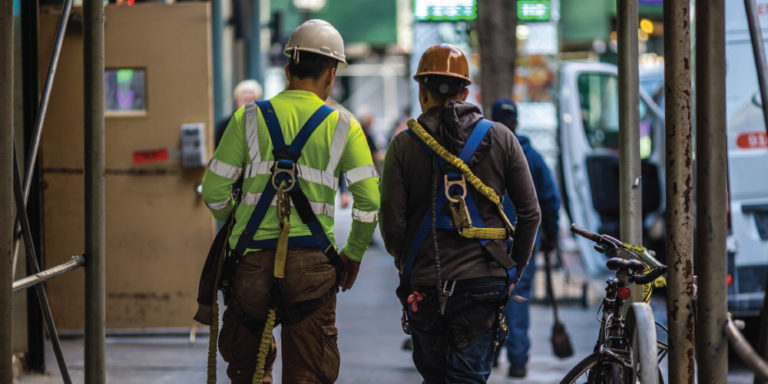— 6 min read
5 Common Construction Site Hazards and How to Mitigate Them
Last Updated Dec 8, 2023

Adding the right tools to your toolbox can make your team safer and more efficient with proper construction site hazard mitigation.
Construction projects are inherently dangerous places and managing these risks is a critical responsibility for construction workers and managers. By adding the right tools and software to your toolbox you can keep your workers safer, reduce downtime, and increase efficiency on the job site. Prioritise hazard mitigation and invest in the right software solutions to create a culture of safety and productivity that benefits everyone involved in the project.
Contents
Table of contents
Construction Hazards & Prevention Strategies
According to Safe Work Australia, the construction industry is considered one of the most high-risk sectors when it comes to workplace accidents. Construction projects can involve numerous hazards that pose a risk to workers' safety, prioritising construction safety is crucial for the success of any project. In this guide, we will explore the five most common construction site hazards and how to enhance safety measures and ensure workers' well-being on every project.
Workplace safety on sites is crucial to the health and well-being of workers. It is important for all construction managers to prioritise safety measures and training in order to prevent these common workplace accidents.
Vehicle Accidents
Construction sites often involve the use of heavy equipment and vehicles, such as excavators, bulldozers, and trucks, which can be difficult to manoeuvre and require specialised training to operate safely. Sites often involve a high volume of traffic, with workers, vehicles, and equipment moving in close proximity to one another. This can create hazardous conditions that increase the risk of accidents. In some cases, they may even lack proper safety measures, such as warning signs, barricades, and lighting, which increases the risk of accidents.
How to Mitigate Vehicle Accidents on a Construction Site
To reduce the likelihood of accidents, it is important to provide proper training and equipment for yourself and your workers, establish clear safety protocols and guidelines, and implement effective communication systems to ensure that everyone on the site is aware of potential hazards.
With the advancement of technology, construction quality and safety software have become an increasingly popular solution for improving safety.
Construction quality and safety management software can help mitigate vehicle accidents by ensuring compliance with safety regulations, identifying potential hazards, tracking safety incidents, providing training and education to workers, and assessing risks. By implementing these features, you create a safer work environment and reduce the risk of vehicle accidents on the job site.
Working at Heights
Construction projects often involve working on elevated surfaces, such as scaffolding, ladders, or rooftops, which increases the risk of falls. Workers may also unknowingly and improperly use equipment or climb on surfaces that are not designed to support their weight, leading to falls and other accidents.
How to Mitigate Working at Height Risks on a Construction Site
To prevent accidents while working at heights, you should prioritise safety by providing appropriate equipment, proper training, and regular safety inspections. Construction quality and safety management software help mitigate working at height risks by ensuring compliance with safety regulations, providing real-time safety monitoring, offering training and education to workers, managing non-conformance issues, and conducting auditing and risk assessments. By implementing these features, construction managers can create a safer work environment and reduce height risks on the job site.
Electrical Hazards
Electrical hazard accidents in construction projects are incidents that occur when workers are exposed to live electrical current or are in contact with electrical equipment or systems that are not properly installed, maintained, or grounded. These accidents can result in serious injuries, including electric shock, burns, falls, and even death. Common electrical hazards on construction sites include exposed wiring, faulty or damaged electrical equipment, lack of grounding or insulation, and contact with overhead power lines.
How to Mitigate Electrical Hazards on a Construction Site
Electrical hazards are a significant risk in construction, and it is crucial to have proper safety measures in place to mitigate these risks. Construction quality and safety management software can mitigate electrical hazards by ensuring compliance with safety regulations, providing real-time safety monitoring, offering training and education to workers, managing non-conformance issues, and conducting auditing and risk assessments.
Slips, Trips, and Falls
Slips, trips, and falls are often caused by hazards such as wet or slippery surfaces, uneven surfaces, obstructions or clutter, poor lighting, and unsafe work practices. Slips occur when there is not enough friction between a person's foot and the walking surface. Trips occur when a person's foot strikes an object, causing them to lose their balance, and falls occur when a person is unable to maintain their balance and falls to the ground.
How to Mitigate Slips, Trips, and Falls on a Construction Site
To mitigate slips, trips and falls, construction quality and safety management software can help. You can create a safer work environment by ensuring compliance with safety regulations, providing real-time safety monitoring, offering training and education to workers, managing non-conformance issues, and conducting auditing and risk assessments.
Struck-by Hazards
Struck-by hazards refer to situations in which workers are hit or struck by objects. These hazards are a significant risk for construction workers, as they can cause serious injuries or fatalities.
How to Mitigate Struck-by Hazards on a Construction Site
You should assess the work site to identify potential struck-by hazards and implement measures to eliminate or control them. Construction quality management software minimises struck-by hazards by providing real-time hazard tracking, daily assessments, task management, digital documentation, and safety training.
Preventing Construction Site Hazards with Construction Safety Management Software
Construction safety is a top priority for any project. Ensuring the safety of your crews is crucial. Utilising a reliable construction quality management tool can make a significant difference in maintaining safety at your construction site.
Procore
Procore offers a comprehensive platform for head contractors and subcontractors that helps you manage quality and safety aspects of your project. From real-time hazard tracking to daily assessments, task management, digital documentation, and safety training, our software helps ensure that your job site is a safer workspace for everyone. Improve your construction quality and safety in one place with Procore.
Book a free demo and discover how Procore’s software can help you make sure that your whole crew makes it home safely, night after night.
Categories:
Tags:
Written by
Emma De Francesco
16 articles
Emma is currently Strategic Product Consultant at Procore where she loves partnering with clients to help them achieve the best possible results. She has worked as a Project Manager in previous roles, responsible for overseeing small to medium-sized projects across various sectors including commercial, health and lifestyle, retail, government and hotels. Throughout these projects, she managed everything from project costs, program and quality & safety, to design management, procurement, and authority approvals.
View profileExplore more helpful resources

Construction Defect Lists Explained
A defect list is a document that lists the final tasks remaining before a construction project — or scope of work — is considered complete. Builders add all work that...

Construction Estimating: The Building Blocks to Success
Construction estimating is a crucial process in the construction industry, as it involves accurately predicting the cost of a project before work begins. Within Australia and New Zealand, construction estimating...

RFQs Explained: How Contractors Prove Their Qualifications
In the construction industry, the term RFQ can mean two very different things: a request for qualifications, or a request for quote. When an owner-developer uses a request for qualifications...

RFIs: A Contractor’s Guide to Requests for Information
Head contractors spend a lot of time waiting for owner-developers to respond to their requests for information (RFI). So much so, that if they were to add up all the...